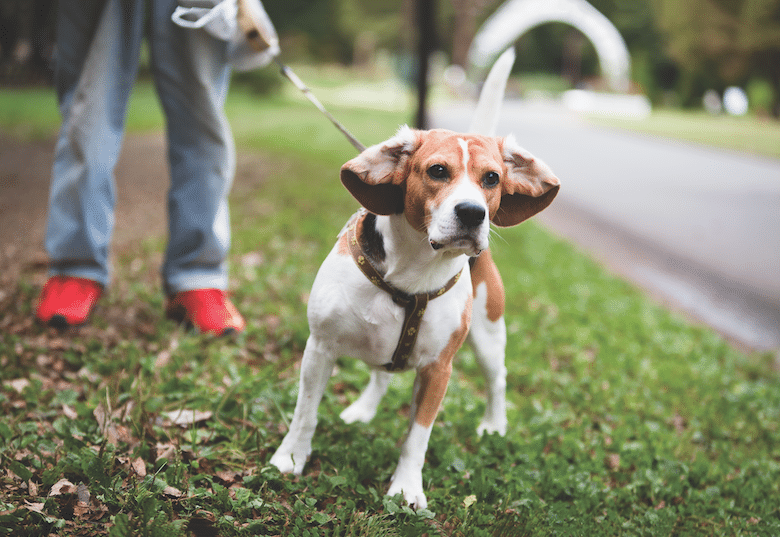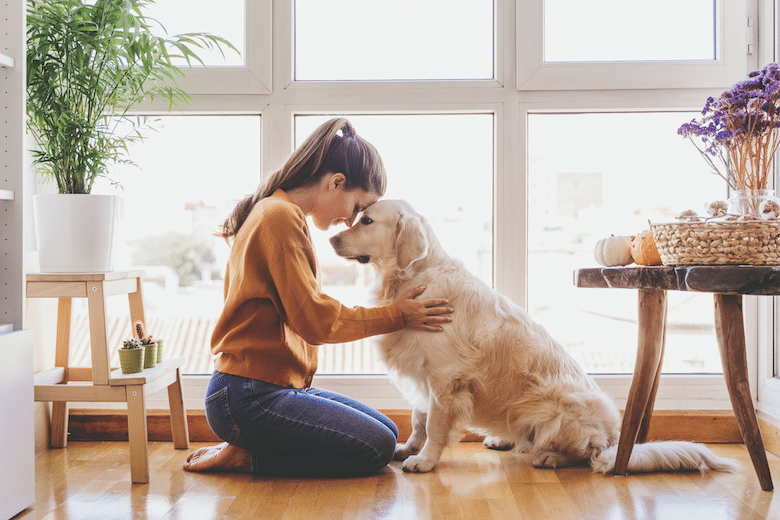Does Your Dog Have an Anxiety Issue?
When you buy through links on our site, we may earn an affiliate commission.
Dogs are emotional beings with different personalities and temperaments, telling us how they feel through their own language — body language. If we don’t know how to read dogs, we can miss their communication, forcing them to get bigger and bigger with their body language, so that we have no choice but to finally hear them.
What is dog anxiety?
Let’s first define anxiety, so we know whether to even treat it. Anxiety is …
• a feeling of worry, nervousness or unease, typically about an imminent event or something with an uncertain outcome
• desire to do something, typically accompanied by unease
• a nervous disorder characterized by a state of excessive uneasiness and apprehension, typically with compulsive behavior or panic attacks.
The third definition is the one we would label anxiety and would need to treat by helping our dogs feel less anxious about whatever triggers them. The first two are opportunities for us to help them before it turns into a disorder needing to be helped via positive reinforcement training through counter condition or desensitization methods.

Photo: MivPiv | Getty Images
What are the signs of dog anxiety?
Signs of anxiety can be subtle or grand. Grandiosity in dogs shows up in obvious behaviors, such as:
➻ barking
➻ lunging
➻ biting
➻ hyperactivity
➻ being destructive
Displacement behaviors often go unnoticed because they aren’t understood as signs of anxiety. These not-so-obvious behaviors are:
➻ scratching, when they don’t have
an itch
➻ lip licking, when they haven’t just eaten
➻ panting, when they’re not hot
➻ yawning, when they’re not tired.
If we miss noticing these anxiety communications, it forces our dogs to tell us in a bigger and bigger way how they’re feeling. When this happens, there is a lot of unlearning to do to change the behavior, which fits into the last definition of anxiety.
When dogs are behaving “badly,” they aren’t being bad — they are expressing anxiety and this “bad” behavior helps them feel less anxious. Relieving their anxiety goes a long way to mitigating an unwanted behavior rather than correcting an already anxious dog.

Photo: Eva Blanco | Getty Images
What are the causes of anxiety?
Some common anxieties in dogs are:
➻ separation anxiety
➻ anxiety at the vet’s office
➻ anxiety in training
➻ anxious around kids, cats, horses
➻ anxious around cars; getting in or chasing them
➻ noises like thunder, trains, etc
Build trust not anxiety
Whatever the anxiety or however deep-seated it is, relieve your dog’s anxiety, don’t correct him. Do this by changing the association to the trigger that causes the anxiety by pairing something good with the trigger before your dog gets over the threshold and too anxious.
Some anxieties aren’t really anxiety at all. Balking at a statue on a walk when your pup is 14 weeks old isn’t anxiety —it’s caution when faced with something new. How we handle the reaction can either cause anxiety or build trust.
If your dog balks, barks, lunges or pulls away:
➻ stay put and talk in a soothing voice.
➻ allow your pup time to adjust to the new object or person.
➻ When your dog’s body has relaxed, move forward offering treats by luring him toward the object of anxiety.
Throw treats on the ground, getting closer and closer to the object until your dog realizes that it’s not going to hurt him.
Use these as opportunities to learn that life is fun, not scary.

Photo: gollykim| Getty Images
How to manage your dog’s anxiety
Let’s look at four common ways we think dogs are behaving badly when they are just expressing anxiety.
Anxiety barking — First, ensure your dog’s basic physical and mental needs have been met. Next, manage the environment by creating a quiet place where the dog feels safe: Put something over the windows like an opaque, removable film, leave the radio or TV on a classical music station, block off areas that trigger anxiety. Then, work with a trainer to use positive reinforcement to desensitize your dog to whatever triggers his anxious barking.
Lunging — Lunging is a manifestation of your dog’s emotional state. Don’t focus on stopping the behavior but on decreasing the anxiety to help mitigate lunging.
First, create more distance between your dog and the trigger to help keep your dog under the reactive threshold. If your dog is so caught up that he isn’t able to hear you or take treats, then you’re too close to the trigger. Either remove your dog or create more distance. Next, work with a positive reinforcement trainer to help desensitize your dog so that you can decrease the distance, while keeping him under threshold.
Biting — Dogs rarely bite out of the blue. First signs often go unnoticed, because they are subtle — looking away, lip licking, yawning, scratching and sniffing. When these signals are missed, the dog needs to get bigger in his communication: showing teeth, air snapping, growling, or hiding behind or under furniture. When these bigger signs go misunderstood, dogs are left with no alternative but to bite. (Although they did try to tell you.) Learn to read these signs with the Dog Decoder app (On Google Play and Apple app store).
Destruction — When dogs are destructive when left alone, it’s because they have separation anxiety. First, ensure your dog’s physical and mental needs are met. Second, establish a place where your dog feels safe — this place should be determined by your dog, not you.
Experiment with different places: the office, the kitchen or family room, wherever you spend much of your time. Block off that area with a puppy gate, like this extra-wide one from FRISCO ($34.99, Chewy), and practice leaving for short periods (and I mean short). Get something out of another room while your dog is calm and relaxed.
Some dogs feel safe in an even smaller place like an exercise pen or crate. Once you find the safe place, get help from a positive trainer to teach you how to lengthen the time away from your dog so you can help him feel less anxious about being alone.
When your dog shows displacement behaviors like scratching, panting, yawning and lip licking — and they happen out of context (he doesn’t really have an itch, he isn’t really smelling something or he’s not tired but is yawning) — these are signs that he feels some discomfort. When you notice these signs, pay attention to what’s happening at the moment and help him feel less anxious.
Can you move a bit farther away from the trigger? Can you soothe your dog with a gentle calming voice and touch? If your dog is playing with other dogs, remove him and come back another day. If your dog is anxious at the vet clinic, go for daily, non-vet, friendly visits to get treats and go home.
Work with a trainer who specializes in low-stress handling to help your dog not fear being handled, having his nails trimmed, ears touched and temperature taken.
Understanding and management are critical to help any dog feel less anxious about whatever triggers them. Use positive reinforcement to change the association from fear or anxiety to relief. Build up your trust account and be your dog’s best advocate.
Featured Image: Capuski | Getty Images
